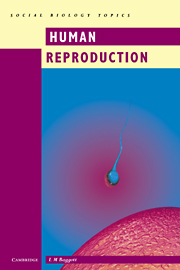Book contents
- Frontmatter
- Contents
- 1 Human reproductive strategies
- 2 Gamete production
- 3 Fertilisation
- 4 Implantation and pregnancy
- 5 Birth and lactation
- 6 Contraception
- 7 Human infertility: background and causes
- 8 Human subfertility: options and treatment
- 9 Ethical and moral considerations of fertility and infertility
- Index
4 - Implantation and pregnancy
Published online by Cambridge University Press: 05 June 2012
- Frontmatter
- Contents
- 1 Human reproductive strategies
- 2 Gamete production
- 3 Fertilisation
- 4 Implantation and pregnancy
- 5 Birth and lactation
- 6 Contraception
- 7 Human infertility: background and causes
- 8 Human subfertility: options and treatment
- 9 Ethical and moral considerations of fertility and infertility
- Index
Summary
Significance of viviparity
The oocyte is one of the biggest cells in the human body, and this is due mainly to the relatively large amount of cytoplasm which it contains. A major constituent of this ooplasm is yolk which is the main nutritional source for the embryo in its initial stage of development. Yolk is a mixture of lipids and proteins which provide the energy required for what is a very rapid period of biological change. The oocytes of all animals contain yolk, but the relative amount depends upon the degree of isolation of the embryo from other sources of nutrition. Birds and reptiles, for example, must complete all of their embryological development from zygote to hatchling within the confines of the egg shell, so they invariably have very yolky or teleolecithal eggs. Those species whose embryos derive their nourishment entirely from the egg yolk are described as oviparous.
The eggs of mammals contain relatively little yolk compared with the eggs of other vertebrate species. However, yolk is present in sufficient quantity to sustain the development of the early embryo through the period of cleavage. This term is used to describe the first few cell cycles of a multicellular organism developing from a single fertilised oocyte. Mammalian eggs are termed alecithal (figures 2.9 and 2.10).
In placental mammals, including of course humans, cleavage takes place as the embryo passes down the Fallopian tube towards the uterus. During this period, the embryo draws upon the reserves of yolk in the dividing cells.
- Type
- Chapter
- Information
- Human Reproduction , pp. 33 - 54Publisher: Cambridge University PressPrint publication year: 1997



